Point and shoot film cameras to fit in your pocket on the next trip
The hallmarks of point and shoot film cameras are their small weight and size, ease of use, and low price. Don’t expect high-quality shots from them, as they come with simple non-professional lenses and a small set of features. At the same time, they are excellent companions at friend gatherings, on family holidays, on trips, and so on.
In this article, I collected a description of a variety of models, the cost of which starts from $24 to $1800. It doesn’t matter if you are a beginner or a professional photographer, by reading this article you can find your best point and shoot film camera.
When choosing cameras, I looked at their weight – 310g and less is perfect for point and shoot 35mm film cameras. I also took into account whether the device is equipped with a flash and quick autofocus. Size and portability are also important parameters of such cameras. I tried to choose devices that would satisfy any wallet. Among the selected models there are both new and old cameras, tested by several generations of photographers.
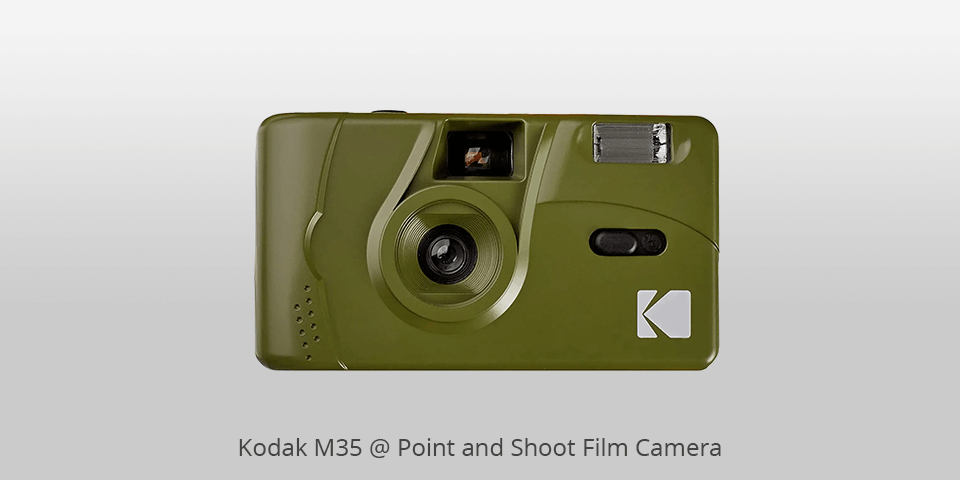
Film format: 135 Film (24x36mm) ISO 200/400 | Lens: 31mm, f/10, 1 element | Shutter speed: 1/120s | Focusing: Focus Free, 1M to ∞ | Dimensions: 114 x 63 x 35 mm | Weight: 100g
This compact reusable camera works with 35mm film. It comes with a flash, a 31mm fixed focus lens, a convenient on/off switch, and manual film rewind. I liked how easy it is to change film in this film camera. Alternatively, you can use the manufacturer's instructions.
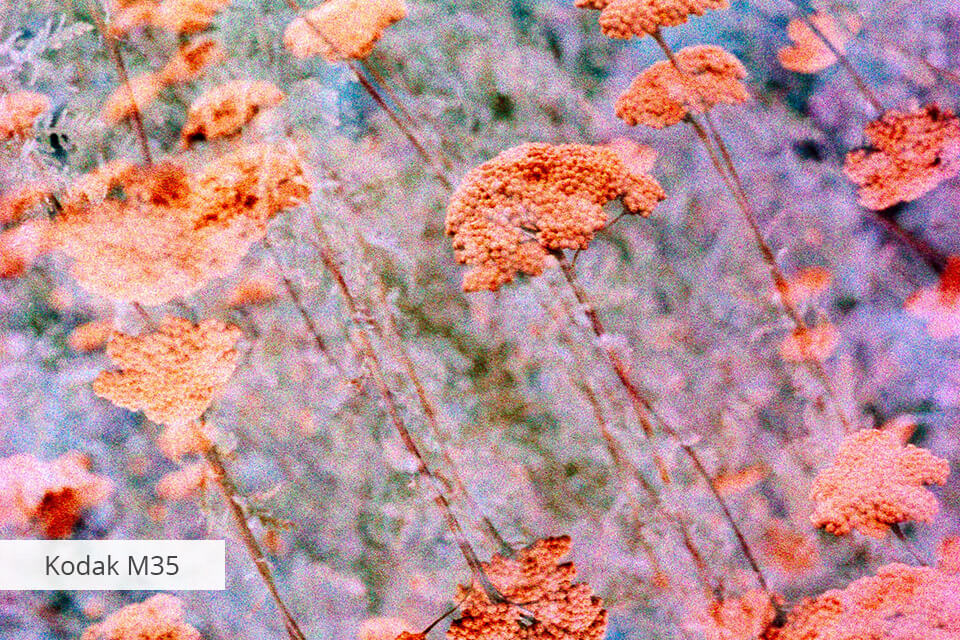
In terms of power, only one AAA alkaline battery is necessary for it. The cycle of operation of this best point and shoot camera under $100 is very simple – installation of film, shooting, film rewinding, and its development.
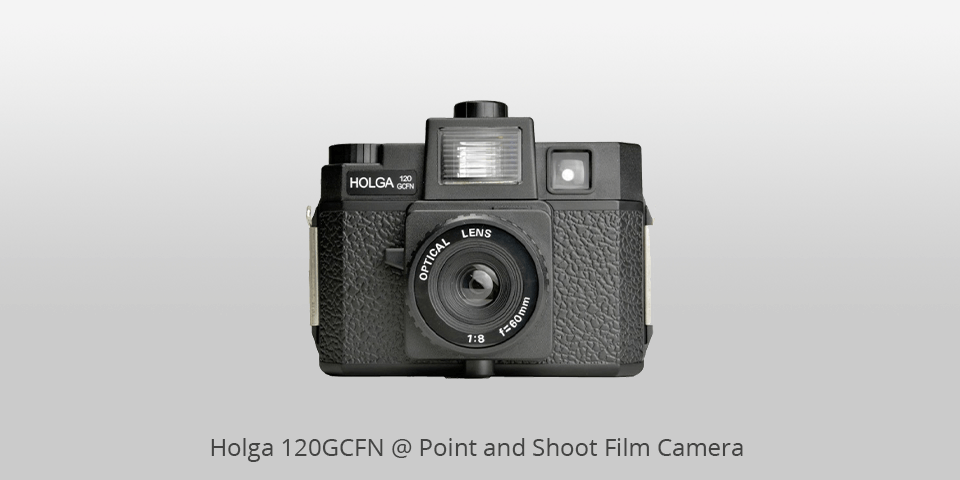
Film format: 120 medium format film | Lens: 60mm f/8 glass lens | Shutter speed: 1/100s | Focusing: Zone focusing system, up to 3' away | Dimensions: 7 x 5 x 5 inches | Weight: 11.3 ounces
This point and shoot film camera 35mm features high-quality photos and an original flash capable of changing color due to a rotating color wheel. The device is equipped with a lens made of glass, unlike most analogs that come with a plastic one. Thus, your picture will turn out to be more contrasted and clear without losing quality. Also, this camera from Holga will give your photos a nice effect of vignetting and curvature of the field.
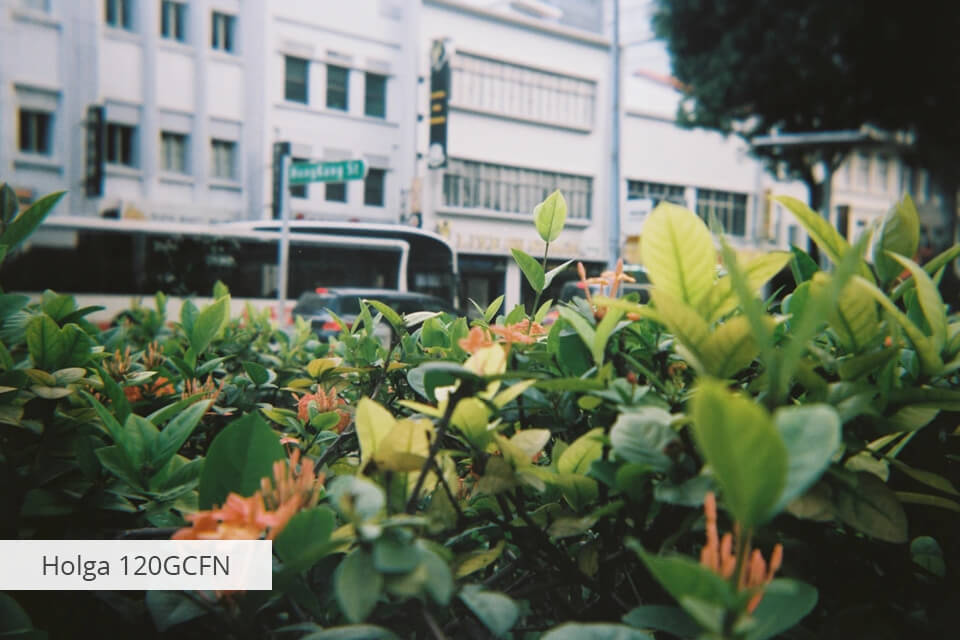
This camera has options to choose from f/8 or f/11, cloudy or sunny mode, multiple aperture parameters, 1/100 sec, or bulb shutter. What’s more, you can also choose to focus in a zone or focus as close as 3 feet.
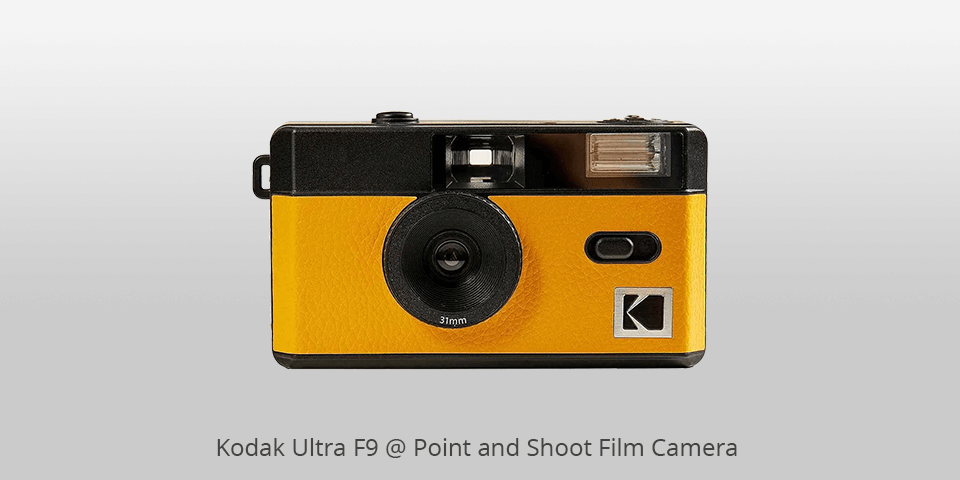
Film format: 135 Film (24x36mm)ISO 200/400 | Lens: 31mm, F=9, 1 element | Shutter speed: 1/120s | Focusing: Focus free | Dimensions: 119(W) x 67(H) x 44(D) mm | Weight: 170g
This compact film camera is a great option for photography beginners as it is extremely easy to use and comes with everything you need to take pictures. It has a crisp f/9 lens and a powerful enough flash so you can be sure your shots will be properly lit. Its lens has a fairly wide field of view, and its f/9 aperture provides proper focus, so you can expect wide-angle, well-focused photos.
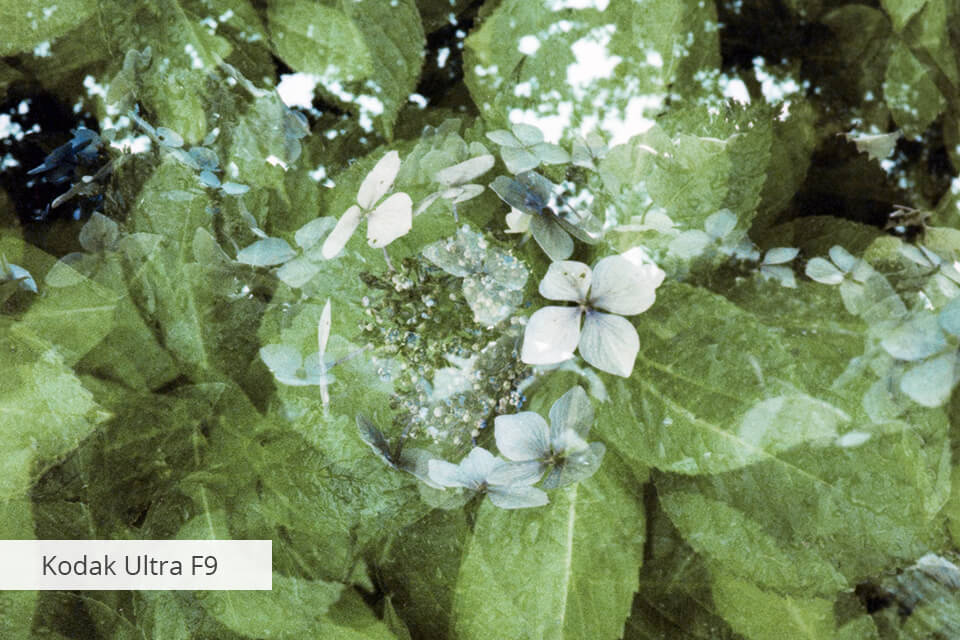
The features of this device are the presence of an optical viewfinder, exposure counter, lightness, and portability. All this makes it a reliable choice and popular among amateur photographers.
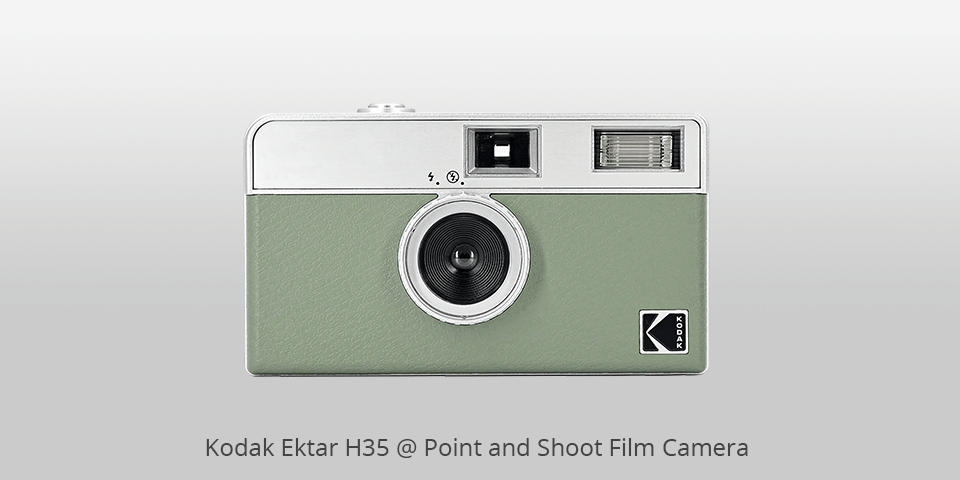
Film format: 35mm (Half Frame) | Lens: 22mm; F9.5; 2-element optical grade acrylic lens | Shutter speed: 1/100s | Focusing: Focus free | Dimensions: 110(W) x 62(H) x 39(D) mm | Weight: 110g
This compact and lightweight film point and shoot camera is designed to be carried around without any discomfort. The device takes amazingly clear and detailed pictures. If you prefer contrasted photos, try high-contrast film and you’ll be pleasantly surprised by the results. In terms of technical specifications, the camera comes with a fixed 22mm f9.5 lens and a shutter speed of 1/100th of a second.
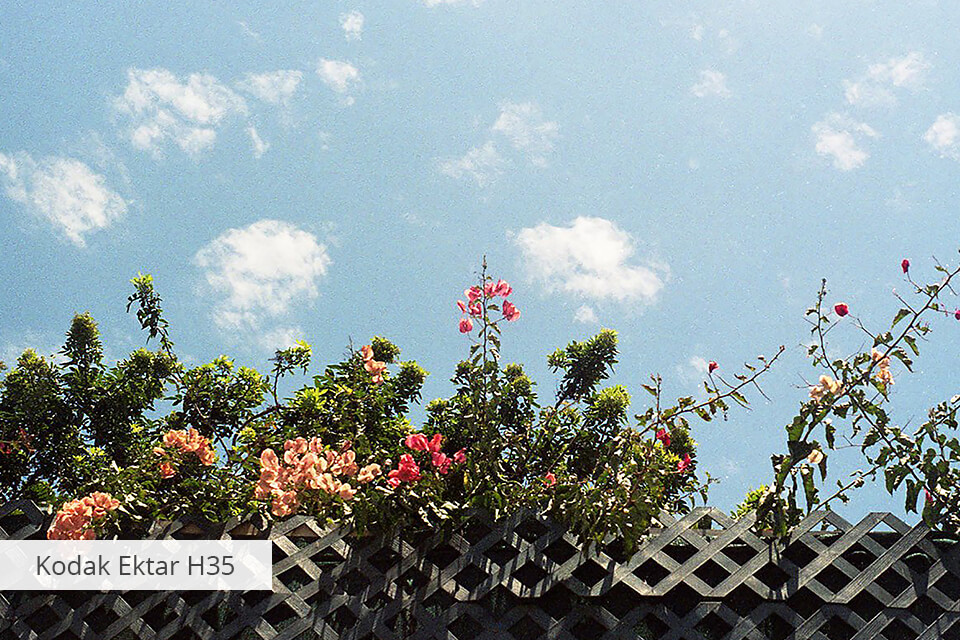
This camera is universal in terms of application. Whether you are a professional or a beginner, a portrait or a landscape photographer, it will satisfy your requirements.
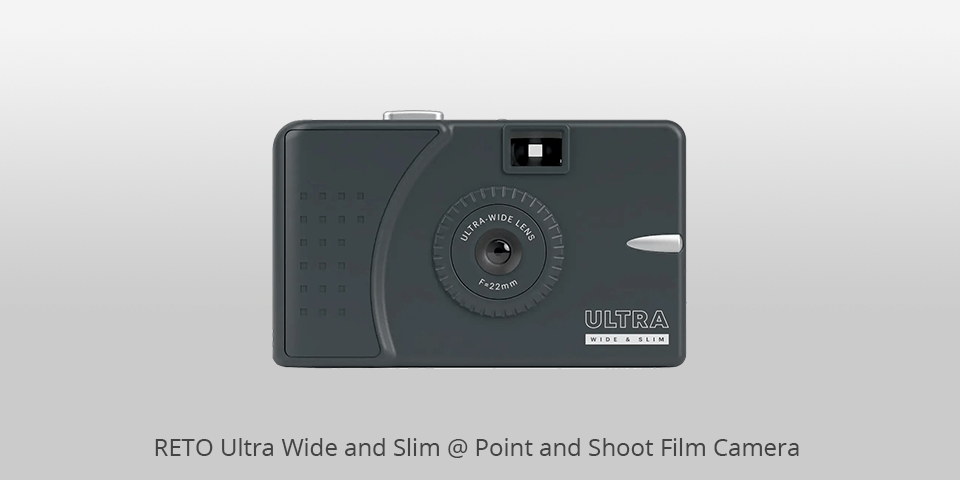
Film format: 35mm | Lens: 22mm ultra wide lens | Shutter speed: 1/125s | Focusing: Focus-free; 1 - inf | Dimensions: 3.94 x 1.1 x 2.32 inches | Weight: 69g
This model could be your best point and shoot film camera if you are looking for something simple, compact, and lightweight. Its small weight is explained by the fact that it is made of plastic and works without batteries. At the same time, it comes with a single shutter speed of 1/125 second, a fixed aperture of f11, and a two-component lens without focus.
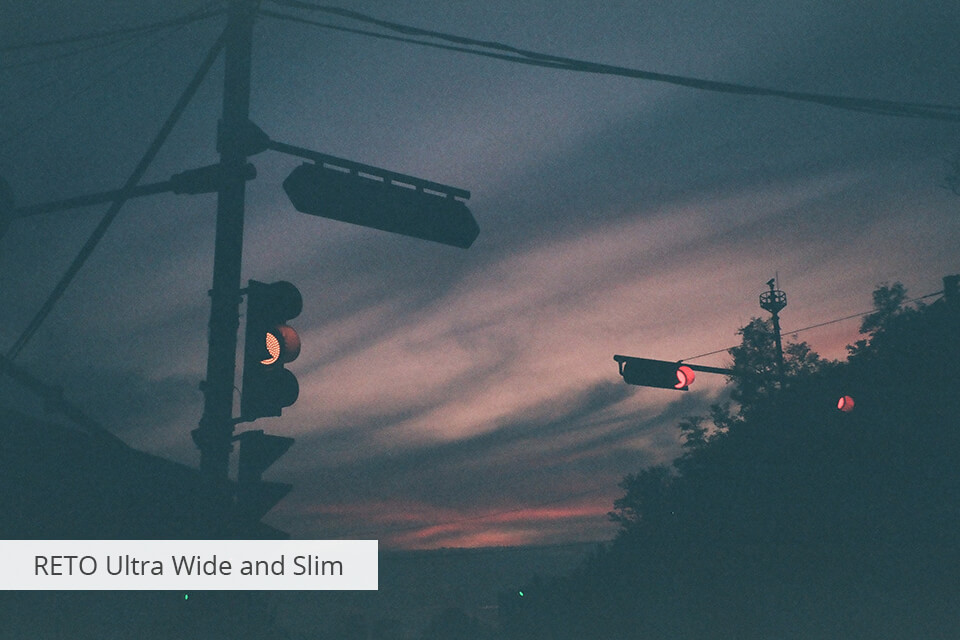
Being made of plastic, this 22mm ultra-wide lens allows shooting on film wide angle shots such as landscapes that fit well in the frame. Weighing only 69g, this camera fits easily into your pocket, making it highly portable.
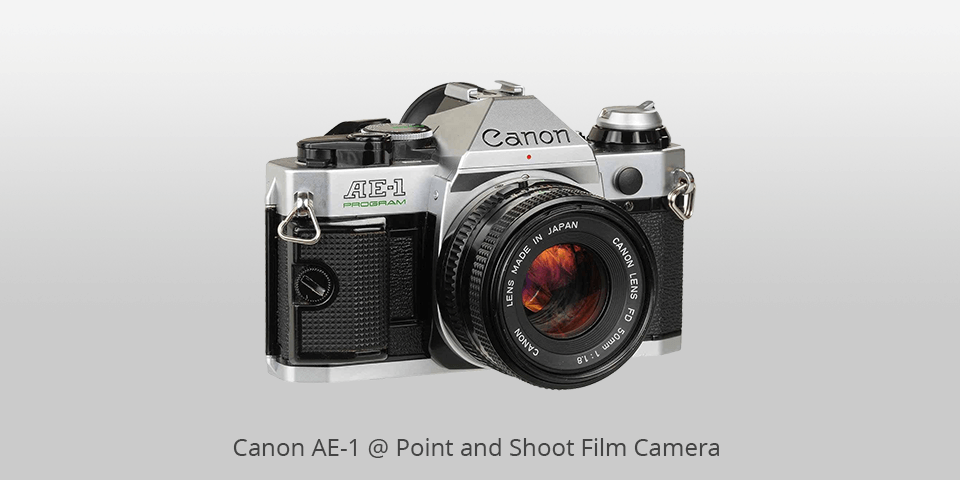
Film format: 35mm | Lens: All Canon FD lenses | Shutter speed: 13 options, from 1/1000 of a second to 2 seconds | Focusing: - | Dimensions: 141×87×48 mm | Weight: 590g
Unlike previous Canon point and shoot 35mm film cameras, this model combines metal and plastic parts in its design. It comes with an FD breech-lock lens mount that all Canon’s FD and New FD series lenses support. Speaking of shutter speed settings, this device offers a manual dial with 13 settings from 1/1000 second to 2 seconds. By controlling the shutter, you can also manually set B stop values from 1.2 to 22.
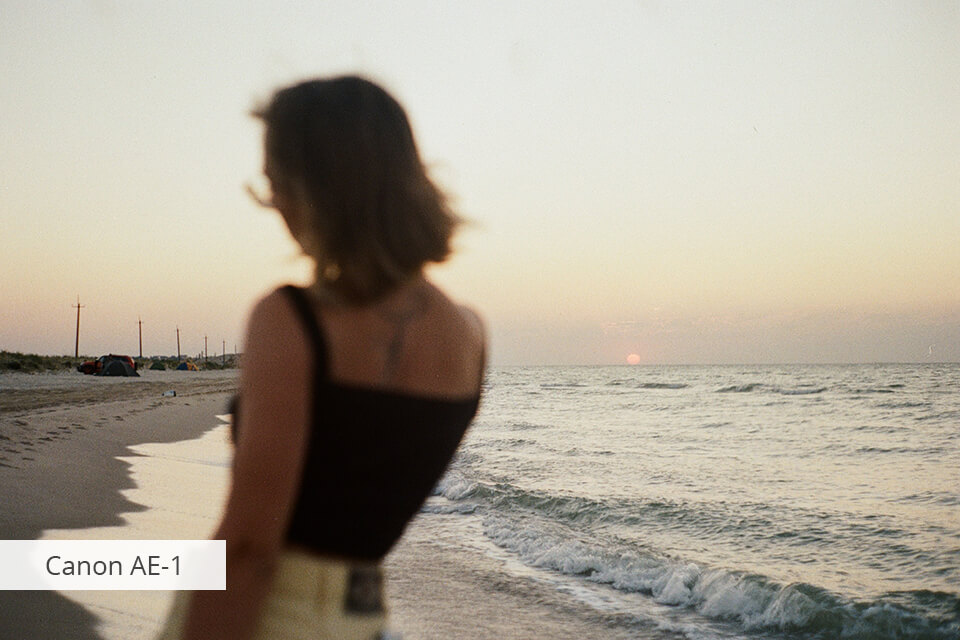
The quality of pictures taken with this model deserves special attention. After developing the film, you can enjoy atmospheric, clear, and bright photos. Besides, you can use any of the best film scanners to multiply shots and create mesmerizing collages. This vintage camera is especially popular with intermediate photographers with a passion for 35mm shots.
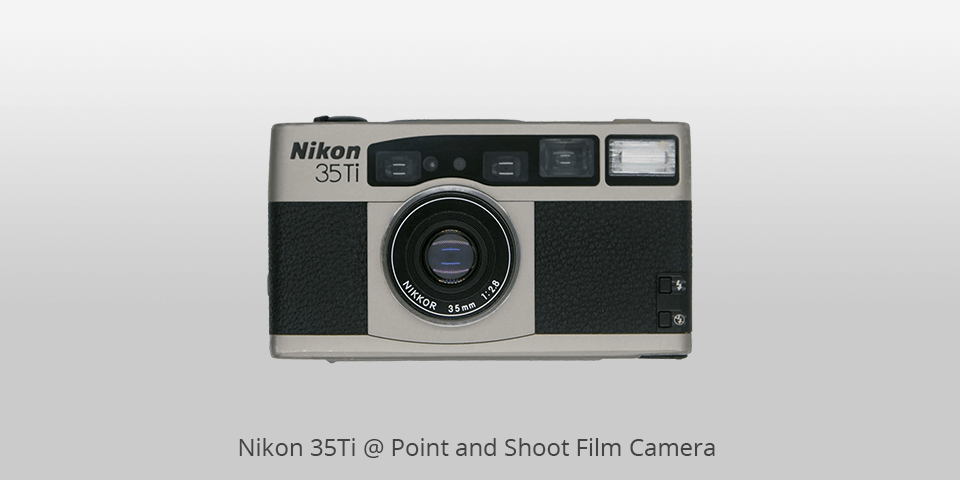
Film format: Normal (24mm x 36mm); Panorama (13mm x 36mm); ISO 25 to 5000 | Lens: Nikkor 35mm f/2.8 lens | Shutter speed: 1/500 sec. to 2 sec. | Focusing: Autofocus, Infinity Focus and Preset focus | Dimensions: 118 x 66 x 36mm | Weight: 310g
Like other proven brands, this Nikon point and shoot film camera 35mm offers you stunningly clear, glare-free shots thanks to its special coating. Its handy titanium build combines manual focusing, time/date imprinting, and exposure compensation.
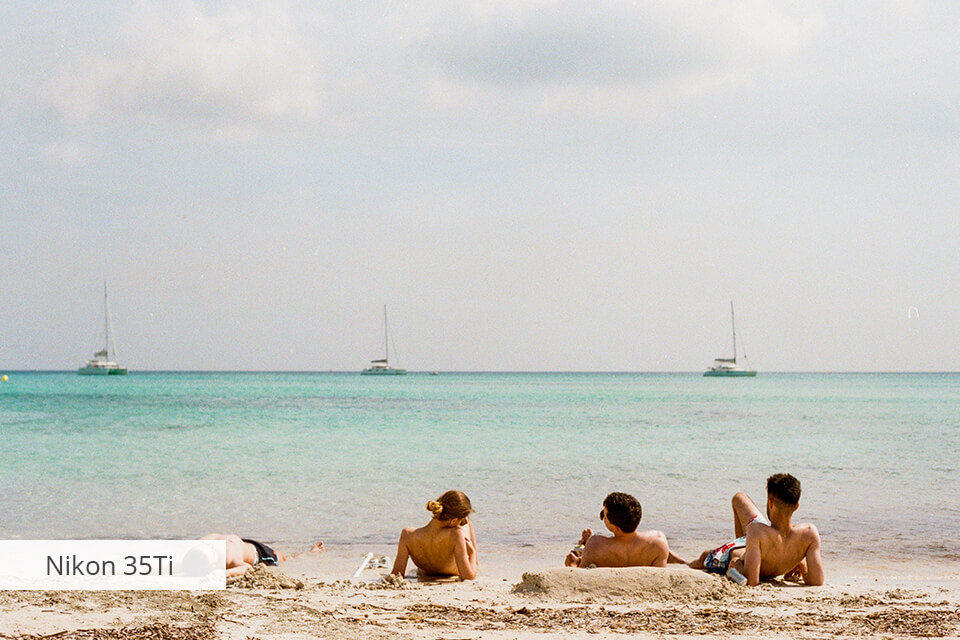
The camera is very easy to use and comes with fast autofocus. Here you will find three modes – A, P, and T, which stand for Aperture Priority, Program, and long exposures (“bulb”) respectively. The creators equipped their product with an innovation – an analog display that indicates aperture data, exposure compensation, and exposure number and is located at the top of the camera.
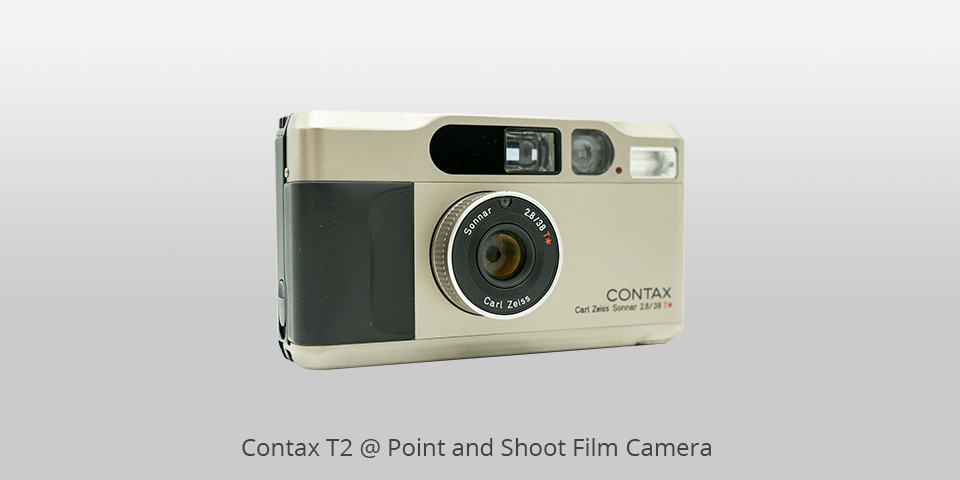
Film format: 35mm, 25 – 5000 | Lens: 38mm f/2.8 | Shutter speed: 8s – 1/500 | Focusing: Autofocus | Dimensions: 119 x 66 x 33mm | Weight: 295g
This film point and shoot camera comes with a top-notch Carl Zeiss 38mm f/2.8 lens and a powerful titanium body, making it highly portable and reliable in all conditions. It features highly automated functions such as autofocus and program AE. However, you can still adjust them manually if you need to achieve sharper and better pictures.
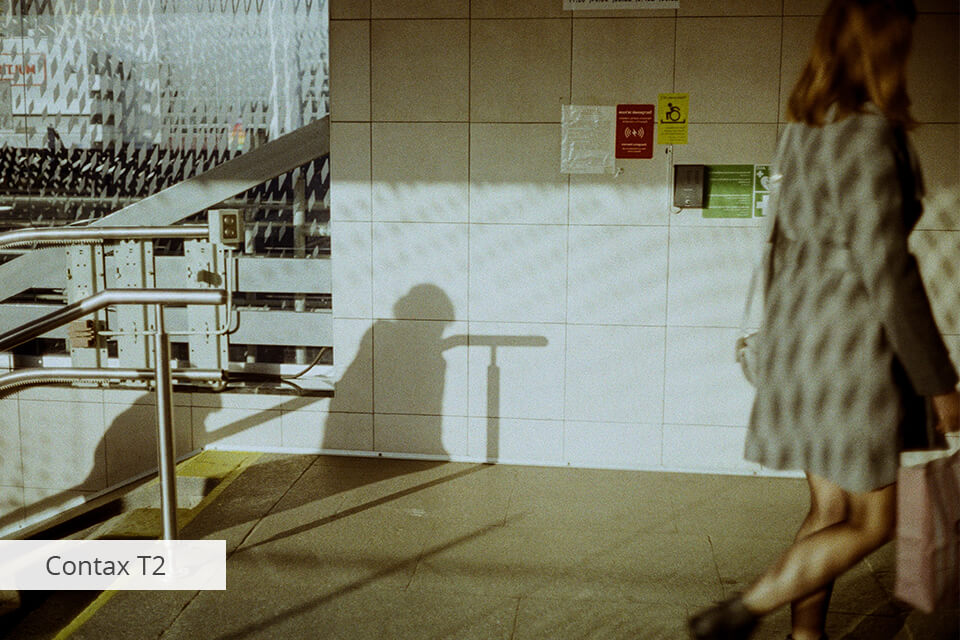
You should be aware that this camera has been discontinued. Its users noted one main drawback – it failed. It is also impossible not to notice its high cost.
| IMAGE | NAME | FEATURES | |
|---|---|---|---|

|
Kodak M35
OUR CHOICE
|
CHECK PRICE → | |

|
Holga 120GCFN
COLOR FLASH
|
CHECK PRICE → | |

|
Kodak Ultra F9
BEGINNER
|
CHECK PRICE → |
Before you chose your best point and shoot film camera, look at the quality of the photos taken with it. Also, consider maximum battery life, portability, and ease of use and control.
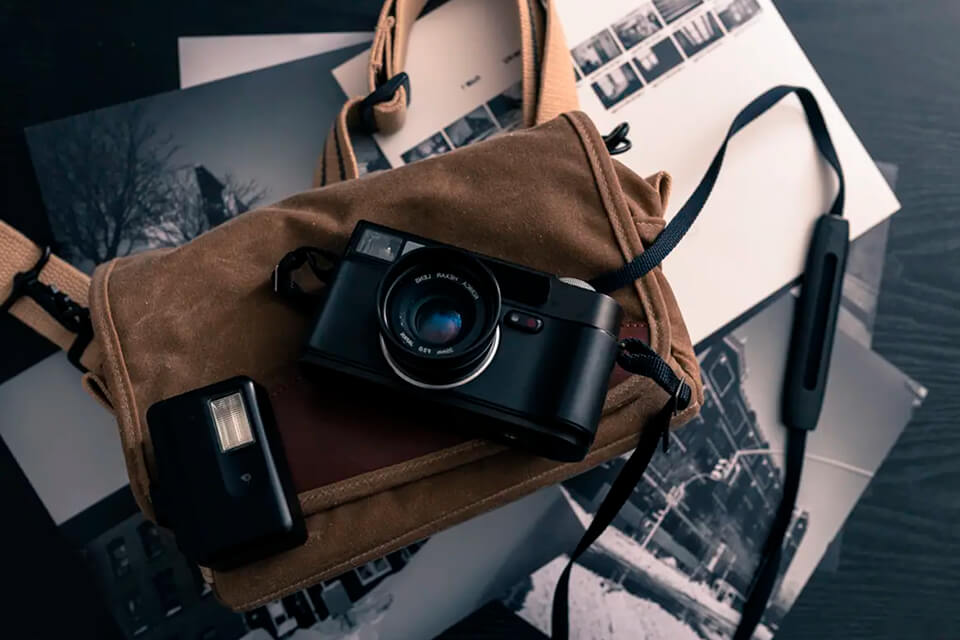
Be sure to consider how, how often, and where you travel. The camera should not interfere with you, but on the contrary, should be your faithful companion. If you are used to traveling light, then take a closer look at compact, simple models. They are perfect for those who do not pursue super quality pictures but simply want to keep pictures of their vacation as a keepsake.
However, if you are willing to carry a separate camera bag with you and the quality of photos and camera functionality is important for you, then choose a reliable, powerful, and top-quality model.
If you’re new to the world of film photo shoots, it’s best to start your journey with a camera fitted with program mode. This mode does a great job of doing all the careful and complex work for you until you learn how to do it yourself. Consider the Canon AE-1, which is perfect for everyone. It comes with a shutter priority which automatically adjusts the aperture value based on the shutter speed you choose.
It is best if your point and shoot film camera 35mm lens is made of glass. If you choose a model with a plastic lens, then do not count on high-quality photos. For example, look at the pictures taken on Lomo. Some time ago they were in trend with their blurry edges blending into the color of the picture. This is not what you need if you are going to study film photography in depth.
A thorough examination of the camera's physical condition can provide valuable insights into its functionality and potential issues.
Firstly, carefully check the exterior of the camera body. Look for any visible signs of damage, such as scratches, dents, or cracks. These could indicate rough handling or possible impacts that may have affected the camera's internal components.
Next, pay close attention to the lens. Inspect it for any scratches, fungus, or haze that could compromise image quality. Additionally, ensure that the lens extends and retracts smoothly without any stiffness or unusual noises.
It is also important to check the camera's controls, buttons, and dials to ensure they are responsive and not overly worn or loose.
In addition, inspect the battery compartment for any corrosion or damage that may hinder proper battery insertion and functioning. Lastly, don't forget to check the film compartment and the overall cleanliness of the camera to ensure it has been well-maintained and is free from debris that could impact performance.
Film type of cameras is almost always easy to use with a fairly good arsenal of features. Of course, each brand endows each product with a special set of functions, but the base is usually the same – built-in viewfinder and flash, autofocus, fixed or variable aperture, quick shutter.
What’s more, some point and shoot 35mm film cameras have automatic film handling options. For example, automatic film loading. This feature greatly simplifies life by freeing you from manual manipulation. Another handy automated feature is the automatic film advance. As soon as the film runs out, the camera will automatically rewind it so you don’t have to do it manually.
As a rule, the process of shooting on film cameras does not cause difficulties even for beginners. However, I suggest you take a couple of preliminary steps before shooting: Load film into the camera. Then you should adjust the ISO in case you do not want to shoot on automatic. You can find it on the outside of the film roll. When the ISO is done, move on to the flash. Turn it on or off depending on the lighting and environment. After checking these simple steps, the camera is ready to go.
If you’re looking for something easy to use, fast and light, and choosing between a rangefinder, a single-lens reflex camera, or a compact film camera, then the latter is the one for you. They aren’t finicky and do not require a lot of skills. What’s more, these cameras are relatively inexpensive and handy to carry anywhere due to their compact and lightweight assembly.
Compared to conventional film cameras, this process is easier here. You can choose a model that comes with an automatic film loading option. All you need to do with such a camera is wind the film onto a spool and leave the rest on the camera. Among the films available, 35mm has won the most hearts of photographers. However, the loading process is the same for all types. To load film, follow this procedure: When loading, keep the film roll upright as the protruding spooler tends to go down. Make sure the leader film is aligned with the notches or indications on the inside of the camera or film door. Close the film compartment. Listen carefully to the sounds the camera makes to understand when the loading process is complete.